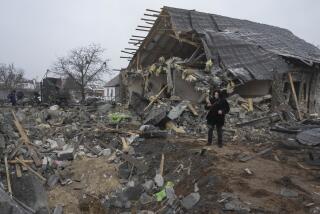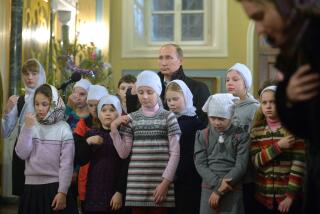Russia Taking Painful Steps to a Free Market
- Share via
MOSCOW — Ending 74 years of socialism, Russia embarks today on the first substantial effort to transform its centrally planned, state-owned economy so that market forces and entrepreneurship predominate in the future.
The first, most painful step will come today with the elimination of almost all government subsidies for consumer goods and a consequent threefold increase in prices for food and many other daily necessities. Two equally far-reaching measures will follow: the privatization of thousands of state-owned enterprises and the breakup of most of Russia’s 24,000 state and collective farms.
The program, virtually a forced march to a market economy, also provides for eliminating the government budget deficit through sharp cuts in military spending and tough fiscal, monetary and banking reforms that together will probably reduce living standards by 30%.
Russian Federation President Boris N. Yeltsin, who won legislative approval of the measures at the end of October, told the nation earlier this week in a television broadcast, “There is no other way.
“The entire world is following the rules that Russia is only now learning,” Yeltsin said of the transition to the free-market system. “We are reforming life primarily for the sake of all people, the common people.”
Still, Yeltsin is worried about an explosion of social discontent as prices soar, factories and farms close and unemployment spreads. Conservatives, including Russian Vice President Alexander V. Rutskoi, are warning against the hardships the reforms will bring. Scattered violence has been reported in the long lines outside Russian stores; two men were killed this week fighting outside a bread shop in the Siberian coal-mining center of Kemerovo.
As outlined by Yegor T. Gaidar, the deputy prime minister for economic policy, Russia will begin to break the decades-old patterns of its state-controlled economy by eliminating virtually all subsidies, permitting enterprises to raise prices to cover their production costs but forcing them for the first time to sell their products at a real price.
Vast changes are expected throughout the Russian economy, where oil, coal and gas are priced much below world levels, where there are huge government subsidies in every sector of industry, where some manufactured goods are sold at profit margins of 600% or 800% and where prices in state-run groceries have remained the same for years, even as farmers have been paid more.
The second task, Gaidar said Wednesday, will be the stabilization on a new plane of the Russian economy, roughly two-thirds that of the former Soviet Union. The object will be to bring the resulting hyper-inflation under control and to channel that energy into long-term growth.
Beyond that, market forces are expected to produce deep, structural changes in the Russian economy under government guidance. Extensive foreign investment will be sought, for example, less for the infusion of capital than for the management know-how, marketing experience and competitive edge.
“The truth is that we don’t know the real cost of production of any item or its true worth in the marketplace,” said a senior economist advising the Russian government. “But we are about to find out--and we hope everything does not come crashing down on our heads.”
Price reform, always a volatile issue, has been taken by the Yeltsin government as the key lever in an overall economic transformation. Almost every Soviet effort at economic reform in the last 30 years, including those proposed by former President Mikhail S. Gorbachev, faltered largely on the issue of price increases.
“Every economist has agreed on reform theory, including real prices, but no government has been able until now to put those prices into effect,” the senior economist advising the Russian government said at a press briefing this week. “The point is not that this is historic, a watershed, although it is; the point is that, finally, fundamental decisions have been made.”
By forcing enterprises to pay real costs for materials, labor and, eventually, capital, the government hopes that it will introduce supply-and-demand considerations into the economy. Higher prices and larger profits should be an incentive to enterprises to produce more goods, ending chronic shortages that resulted from below-cost prices. With subsidies eliminated, the government budget should be balanced, especially with cuts in military spending and higher taxes on business profits.
State-set ceilings on pay have been lifted in most industries in anticipation of inflation; Yeltsin has already increased the pay of government employees, including soldiers, by 90%. Government economists expect that, as prices rise, workers will negotiate compensating pay increases--in contracts that allow employers to cut staffs and demand greater efficiency.
From the increase in prices, the government also expects privatization to develop for potential investors--whether they be an enterprise’s managers or employees, local banks or multinational companies. They will be able to assess a firm’s profitability, and thus its suitability for further investment.
Yeltsin’s government, acting under a determined “Russia first” policy, declared its intention to proceed with the reforms, leaving the other former Soviet republics in the new Commonwealth of Independent States scrambling to keep up. Ukraine and Belarus will also free prices from state controls today, but other republics have yet to work out their policies.
All of this is a dramatic break from the system of central planning that has been the heart of the Soviet economy from the 1917 Bolshevik Revolution.
With subsidies and state price controls gone, consumer prices are expected to increase sixfold and wholesale prices in industry fivefold, the government estimates, although some economists anticipate that inflation will run at an annualized rate of more than 1,200%.
“The initial shock will be both massive and prolonged,” Gaidar said. “Nothing will be as it was, everything will change. . . .”
For this reason, increases in the prices of some consumer goods, generally foods and essential services, will be limited to 200% or 300%, and the government will step in with further, though much reduced, subsidies, if necessary.
Nikolai P. Shmelev, a leading free-market economist, nonetheless warned Wednesday that Yeltsin is risking widespread unrest by raising prices without sufficient goods, including $10 billion to $15 billion worth of imported items, on store shelves.
Without such an offsetting move, today’s price boosts will be like surgery, like the amputation of an arm without anesthetic, he told the newspaper Rabochaya Tribuna. “The patient’s hands are not tied,” he said. “What if he picks up a knife and attacks the surgeon?”
Shmelev urged that the price increases be combined with privatization of state stores and factories and with compensation for poor individuals and families who need government subsidies.
“The Russian team should not be presented as a gang of bad guys who have decided to destroy the motherland,” he said. “All the measures they are undertaking are both necessary and inevitable. The question is whether they are sufficient.”
Gaidar has defended the measures and the sequence as the only practical approach, saying: “The time for democratic alternatives of reform is running out very fast in Russia. To my mind, we have no choice, and there is nothing to discuss. . . . Our defeat unfortunately would not simply be a failure, but a potentially enormous tragedy for this country.”
But the problems are manifest even at the first stage of the reforms.
The release of products, held back from the market in anticipation of the price increase, is mostly a hope; there are no solid figures on how much has been held back and at what prices manufacturers would release them.
An immediate jump of 250% to 300% in prices is the basis of all government calculations. But economists acknowledge that is only a guess because there is no way to accurately measure demand for many goods.
The government already knows that it does not have enough cash ready for the flood of bank withdrawals likely to begin when prices soar; there is serious concern that a bank run could abort the whole reform effort.
The Russian government mint has tripled its printing of bills, going to new denominations of 200, 500 and 1,000 rubles, although the average worker still makes only 350 to 500 rubles a month. Ukraine, which will free its prices today, plans to issue scrip to make up the deficit.
And until state enterprises are privatized, their monopolies ended and competitors, including foreign firms, are allowed into the market, they will feel little pressure to reduce costs or improve products.
Gaidar said he only hopes that the Russian government will have enough time to work on these problems before it is forced from office. “We have two problems to solve, and each is difficult and requires unpopular decisions,” he said. “We cannot permit ourselves the luxury of simply unfreezing prices and then leaving without stopping inflation.
“In that case, there would be a chance that the second goal--the stabilization of prices, of finances, the economy--will be achieved undemocratically by the second post-Communist government.”
More to Read
Sign up for Essential California
The most important California stories and recommendations in your inbox every morning.
You may occasionally receive promotional content from the Los Angeles Times.










